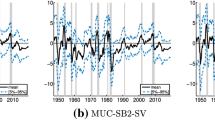Abstract
The claim that volatility of money leads people to increase their demand for money is tested using recently developed cointegration techniques and error-correction modeling. This approach offers an alternative to the standard Granger-causality test for establishing the long-run relation of velocity and money growth variability. In this paper, we employ these procedures on quarterly data from Japan over the 1973:1–1992:1 flexible exchange rate period. Our findings are supportive of the Friedman hypothesis for both the short and long runs. These results are important empirical additions to the new classical theory of economics which suggests that unanticipated movements in the money supply are non-neutral.
Similar content being viewed by others
References
Arize, Augustine C. “Money Growth Volatility and Income Velocity in the United Kingdom,”International Economic Journal 7, no. 3 (Autumn 1993): 43–52.
Bordes, Christian. “Friedman's Velocity Hypothesis.”Economics Letters 32 (1990): 251–255.
Brocato, Joe and Kenneth Smith. “Velocity and the Variability of Money Growth: Evidence from Granger Causality Tests,”Journal of Money, Credit and Banking 21, no. 2 (May 1989): 258–260.
Chowdhury, Abdur. “Velocity and the Variability of Money Growth: Some International Evidence.”Economic Letters 27 (1988): 355–360.
Darrat, Ali F. and M. Osman Suliman. “Volatility of Money Growth and the US Velocity Puzzle: Some Further Results.”Journal of Economics and Business 46 (1994): 77–87.
Engle, R.F. and Granger, C.W.J. “Cointegration and Error-Correction: Representation, Estimation, and Testing.”Econometrica 55 (March 1987): 251–276.
Engle, R.F. and B.S. Yoo. “Forecasting and Testing in Co-Integrated Systems.”Journal of Econometrics 35 (1987): 143–159.
Fisher, Douglas and Apostolos Serletis. “Velocity and the Growth of Money in the United States, 1970–1985.”Journal of Macroeconomics 11 no. 3 (Summer 1989): 323–332.
Friedman, Milton. “Monetary Variability: United States and Japan.”Journal of Money, Credit, and Banking 15 no. 3 (August 1983): 339–343.
Fuller, Wayne A.Introduction to Statistical Time Series. New York: John Wiley & Sons, 1976.
Hall, Alastair. “Testing for a Unit Root in Time Series with Pretest Data-Based Model Selection.”Journal of Business and Economic Statistics 12 no. 4 (October 1994): 461–470.
Hall, Thomas and Nicholas Noble. “Velocity and Variability of Money Growth: Evidence from Granger-Causality Tests.”Journal of Money, Credit and Banking 19 (1987): 112–116.
Johansen, Soren. “Estimation and Hypothesis Testing of Cointegration Vectors in Gaussian Autoregressive Models.”Econometrica 59 (1991): 1551–1580.
McCornac, Dennis C. “Velocity and Money Growth Variability: Evidence form Japan.”Applied Economics Letters 1 (1994): 147–147.
McMillin, W. Douglas. “The Velocity of M1 in the 1980s: Evidence from a Multivariate Time Series Model.”Southern Economic Journal 57 no. 3 (1990): 634–648.
Mehra, Yash. “Velocity and the Variability of Money Growth: Evidence from Granger-Causality Tests.”Journal of Money, Credit, and Banking 21 no. 2 (May 1989): 262–266.
Payne, James E.. “Money Growth and Interest Rate Volatility and the Demand for Money,”Journal of Economics and Finance 16 no. 1 (Spring 1992a): 103–114.
Payne, James E.. “Velocity and Money Growth Variability: Some Further Evidence.”International Review of Economics and Finance 1 no. 2 (1992b): 189–194.
Payne, James E. “Stochastic Structure of Alternative Measures of Velocity.”Journal of Economics and Finance 16 no. 3 (Fall 1992c): 101–111.
Payne, James E.. “Re-Examination of the Velocity-Money Growth Variability Debate.”Journal of Economics and Finance 17 no. 1 (1993): 127–133.
Serletis, Apostolos. “Velocity Effects of Anticipated and Unanticipated Money Growth and its Variability.”Applied Economics 22 (1990): 775–783.
Thornton, John. “Velocity and the Variability of Monetary Growth in the United Kingdom.”Applied Economics 23 (1991): 811–814.
Thornton, John. “Friedman's Money Supply Volatility Hypothesis: Some International Evidence.”Journal of Money, Credit, and Banking 27 no. 1 (1995): 288–292.
Rights and permissions
About this article
Cite this article
Ewing, B.T. Further examination of the velocity-money growth variability debate: Evidence from Japan using an error-correction model. J Econ Finan 20, 21–26 (1996). https://doi.org/10.1007/BF02920603
Issue Date:
DOI: https://doi.org/10.1007/BF02920603




